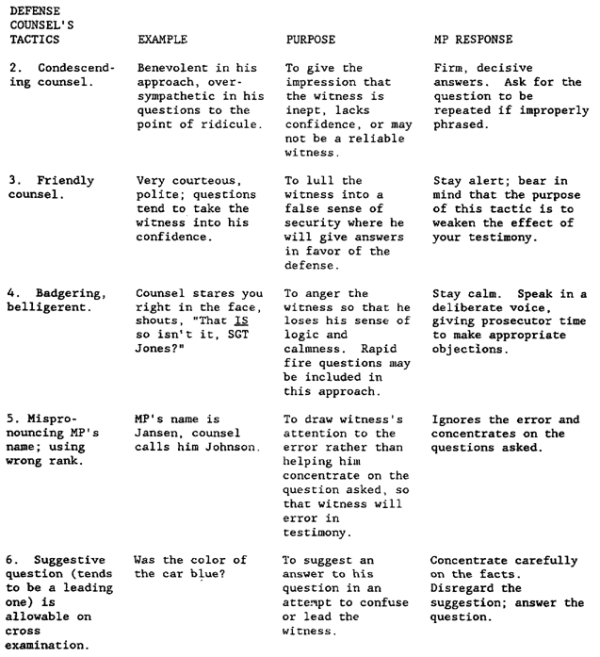


LESSON 4
TESTIFYING IN COURT
Critical Tasks: |
191-390-0153 |
OVERVIEW
LESSON DESCRIPTION:
In this lesson you will learn how to testify in court, boards, and administrative hearings.
TERMINAL LEARNING OBJECTIVE:
| ACTION: | Show the relationship between the original investigation and the subsequent court appearance. Develop basic techniques for testifying in court and identify tactics used in cross examination. |
| CONDITION: | You will have this subcourse. |
| STANDARD: | You must earn a score of 70 percent on the final examination. |
| REFERENCES: | The material contained in this lesson was derived from the following publications: DA Pam 27-10, STP 19-95B1-SM, and TVT 19-57. |
INTRODUCTION
When considering testifying in court, remember this: Each investigation can result in a court-martial or other legal action. The main purpose of an MP investigation is to identify and apprehend suspects. The purpose of the apprehension is to aid a court to evaluate the circumstances of the offense. The court will then decide if the person charged did in fact commit the offense. Testifying in court is a major part of the MP job for two basic reasons.
a. The presentation of evidence in a court marks the last step taken by the MP in a case.
b. The quality and quantity of evidence is a major test of the completeness of the investigation. The effectiveness of presentation of evidence is another major test.
PART A - PRETRIAL RESPONSIBILITIES.
a. In thinking of preparing to testify, remember one fact: The whole investigation process should be thought of as preparation for testifying. Your duties at the scene are to ensure that evidence is properly collected and labeled, measure the adequacy of the investigation and prepare for testifying. Other prior duties that measured such adequacy included locating and interviewing witnesses, and properly recording specifics such as time, weather, etc.
b. Write complete and accurate reports on each incident. Review these reports and your investigative notes (which can be used in court) to refresh your memory. The purpose of your notebook is to "refresh" your memory only.
c. Cooperation with the prosecutor begins before trial. What the MPI knows must be passed on to the prosecutor. This enables both to review the testimony expected of the MP at trial. Conferences with the prosecutor are necessary, ethical, and legal. Therefore, a testifying MP, when asked on cross-examination if he has discussed the case with the prosecutor, should say, "Yes." He should say so without hesitation.
d. Personal appearance. The MP on the witness stand should be clean and neat. He should reflect concern for the details of his appearance. The testifying MP should be cleanly shaved and have a fresh haircut, if male. The MP should leave firearms, handcuffs, keys, etc., out of the courtroom.
a. When an MP is called to testify, he should approach the stand in a serious, businesslike manner. When taking the oath, stand erect with the right hand raised proudly. Look the court officer giving the oath directly in the eyes.
b. After taking the oath, be seated in the witness chair. Sit with BOTH feet flat on the floor. Place your hands in your lap or on the arms of the chair. Do not fidget or rattle change or keys. Don't make any movements or sounds that will distract the court's attention from your testimony.
c. Never use your hands or arms to describe the size of an object or the location of a person in the courtroom. Say in WORDS what needs to be described.
d. Avoid using police lingo. If you apprehended someone, say so rather than "pinched." "grabbed," or "collared." Avoid abbreviated terms like "DWI," etc.
PART C - COURTROOM PROCEDURES AND RULES OF EVIDENCE.
a. The more familiar you are with the courtroom procedure and the rules of evidence, the better witness you will be. Objections made by the defense counsel, based on rules of evidence, can be confusing. This is especially true if you are not familiar with the technical reasons for the objection. If you have a knowledge of the rules of evidence, you may avoid objections through the words you use when replying to questions.
b. When an objection is made, stop your testimony. Wait until the court has ruled on the objection or instructs you to continue. Do not blurt out an answer to a question that is objected to by counsel.
c. Answer all questions in a polite courteous way. After being asked a question, pause. Consider the question carefully. Then give a deliberate answer. If you did not hear or understand the question ask that it be repeated. If you do not know the answer to a question, say, "I don't know." Never "guess" the answer to a question. Refer to your notes when necessary.
d. Never volunteer information. If you know the prosecutor has overlooked an important point, wait until you have been excused and then inform him of the point. If the prosecutor thinks it is important enough, he will recall you to be the witness chair.
e. Do not testify as to opinions or conclusions. Your testimony must be based on facts which you have about the case on trial. Avoid such terms as "I think," "I believe," "In my opinion," etc.
f. Do not argue. MPs who argue with the defense counsel will only antagonize the court. It also gives the impression that he is hostile to the defendant. Rely on the court to control any unfair questioning tactics of the defense counsel.
This is a good method to use for MPs to learn about courtroom procedures and techniques used when testifying: Sit in on an actual court proceeding. In this way you can observe witnesses under fire. You can them become familiar with the more common objections raised during testimony.
PART E - COMMON TACTICS OF CROSS-EXAMINATION.